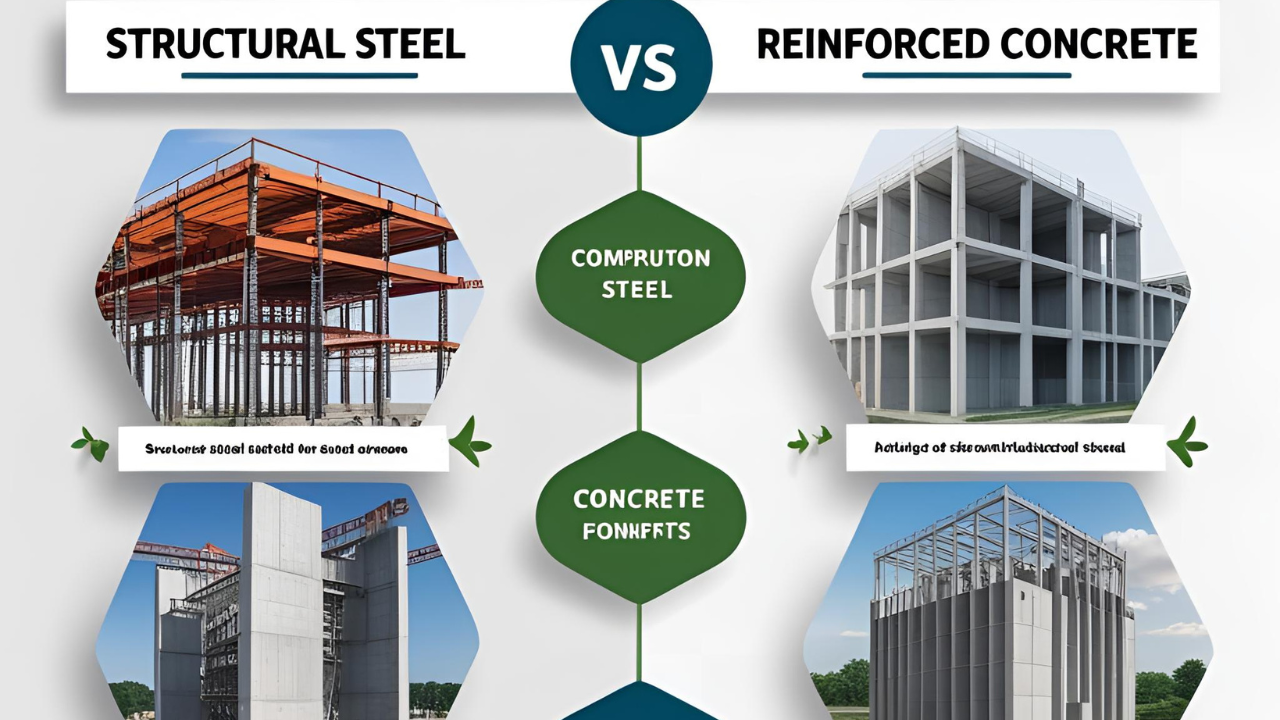Structural materials form the backbone of modern construction. Among the most used materials are structural steel and reinforced concrete. Both have their own benefits and limitations. Choosing between them depends on project type, cost, strength, and other factors. This article offers a clear comparison of structural steel and reinforced concrete to help builders, engineers, and architects decide which is the better option for a particular construction project.
What Is Structural Steel?
Structural steel is a category of steel used to make construction materials in a variety of shapes. It is commonly used in buildings, bridges, and industrial structures. Steel is known for its high strength-to-weight ratio and flexibility.
What Is Reinforced Concrete?
Reinforced concrete is a composite material made of concrete and steel reinforcement bars (rebar). The concrete provides compressive strength, while the steel bars offer tensile strength. It is widely used in buildings, highways, and infrastructure projects.
Comparison: Structural Steel vs Reinforced Concrete
| Feature | Structural Steel | Reinforced Concrete |
|---|---|---|
| Material Composition | Steel (Iron with carbon and other alloys) | Concrete with embedded steel reinforcement bars |
| Strength | High tensile and compressive strength | Good compressive strength, low tensile strength |
| Weight | Lighter than concrete | Heavier than steel |
| Construction Speed | Faster installation with prefabricated components | Slower due to formwork and curing time |
| Flexibility & Ductility | Very flexible and ductile | Less ductile, more brittle |
| Cost | Higher material cost, lower labor cost | Lower material cost, higher labor cost |
| Fire Resistance | Poor without protection | Naturally fire-resistant |
| Maintenance | Requires regular painting or coating to avoid rust | Low maintenance if properly constructed |
| Environmental Impact | Recyclable but high energy use in production | Lower energy use but limited recyclability |
| Durability | Long lifespan with maintenance | Long lifespan with proper design |
| Corrosion Resistance | Prone to rust | Resistant if rebar is well protected |
| Seismic Performance | Excellent for earthquake resistance | Moderate, can crack under high tension |
| Architectural Possibilities | Allows for creative and open designs | Limited flexibility in shape |
Advantages of Structural Steel
- High Strength-to-Weight Ratio: Structural steel offers great strength with less material, making it suitable for tall buildings and long-span structures.
- Faster Construction: Most steel components are pre-engineered and assembled quickly on-site, reducing project time.
- Recyclable: Steel can be reused and recycled multiple times without losing its strength.
- Space Efficiency: Steel columns and beams take up less space than bulky concrete elements, allowing more usable interior space.
Advantages of Reinforced Concrete
- Cost-Effective for Low-Rise Structures: Concrete is usually cheaper for buildings that don’t require tall or complex structures.
- Good Fire Resistance: Concrete does not catch fire or melt, offering better protection in fire-prone areas.
- No Need for Heavy Maintenance: Once set and cured properly, reinforced concrete requires minimal upkeep.
- Sound and Thermal Insulation: Concrete provides better insulation compared to steel, making it ideal for residential use.
Disadvantages of Structural Steel
- Corrosion Risk: Steel can rust if exposed to moisture and not maintained properly.
- Fire Vulnerability: Steel loses strength quickly in high heat unless fireproofed.
- Initial Cost: The cost of steel material and fabrication is often higher than concrete.
Disadvantages of Reinforced Concrete
- Slow Construction Process: Curing concrete takes time, slowing down the pace of construction.
- Heavier Structures: Concrete is significantly heavier, increasing foundation load.
- Prone to Cracking: If not designed properly, reinforced concrete can develop cracks, especially in seismic areas.
Best Use Cases
| Use Case | Preferred Material | Reason |
|---|---|---|
| Skyscrapers | Structural Steel | High strength, lighter structure |
| Bridges | Structural Steel or Concrete | Depends on span and environmental conditions |
| Dams | Reinforced Concrete | Massive weight and strength needed |
| Industrial Buildings | Structural Steel | Flexibility and open space planning |
| Residential Buildings | Reinforced Concrete | Better insulation and lower cost |
| Marine and Coastal Areas | Reinforced Concrete | Better corrosion resistance |
| Earthquake-Prone Zones | Structural Steel | Superior ductility and seismic performance |
Factors to Consider When Choosing
- Budget: If the project has a tight budget, reinforced concrete may be more suitable, especially for smaller or low-rise buildings.
- Timeline: If time is a major factor, structural steel can help complete the project more quickly.
- Design Requirements: For complex designs with large spans and less support, steel offers more flexibility.
- Environmental Conditions: For structures near water or in humid areas, concrete may be better unless steel is well-coated.
- Seismic Zone: In earthquake-sensitive areas, the flexibility of steel structures makes them safer.
Parting Insights
Both structural steel and reinforced concrete have their own unique advantages. The right material depends on your project’s needs, location, budget, and design goals. Structural steel offers speed, flexibility, and strength, making it ideal for tall buildings and fast-track projects. Reinforced concrete, on the other hand, is cost-effective, fire-resistant, and more suitable for sound insulation and stability in long-term structures. A combination of both is also commonly used to take advantage of their respective strengths.

